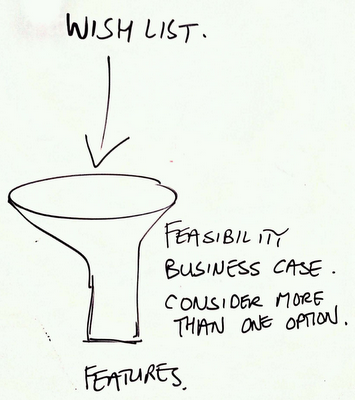The Feature Funnel: A Tool for Managing User Wishlists
The Sales Funnel
Many sales professionals are familiar with the systematic approach to selling a product or service known as the “sales funnel”.
The sales funnel employs the metaphor of a funnel (wide neck at the top, narrow spout at the bottom) to represent the dwindling number of sales prospects that remain after each step in the sales qualification process. Unqualified prospects enter the neck of the funnel and paying customers emerge from its spout.
Each step in the qualification process filters out some of the potential customers based on criteria such as the customer’s need or the customer’s preference for competing products and services.
During a recent course, I was trying to explain the qualification that should be applied to a “wishlist” of software requirements so I drew this picture on the whiteboard.
 The Feature Funnel After the course, I began to think more deeply about what I had sketched and I was immediately struck by the resemblance of my drawing to the sales funnel.
The Feature Funnel After the course, I began to think more deeply about what I had sketched and I was immediately struck by the resemblance of my drawing to the sales funnel.
The “feature funnel” seemed an obvious name for what I had drawn. Using the same metaphor as the sales funnel, the feature funnel represents the systematic process by which an unqualified wishlist of software requirements are gradually refined into a consistent set of product features.
I will write more at a later date about the relationship between Scrum and the feature funnel but for now it is sufficient to mention that Scrum’s product backlog is identical to what I mean by a “consistent set of product features”.
Wishlists We are all familiar with wishlists. They are used to record the desires of individuals or groups. Wordnet tells me, that as well as “expressing a need”, desire includes “the feeling that accompanies an unsatisfied state” and “an inclination to want things”. If the criteria for adding items to a wishlist include “inclinations” and “feelings” it is fairly obvious that wishlists can become quite subjective.
Wishlists are created and managed in a variety of ways. Proactive vendors of software products often establish online wishlists using specialist software such as User Echo. In the absence of a vendor managed wishlist, users often resort to online forums and social networking sites to vent their desires. Vendors ignore these informal wishlists at their peril. Examples abound of software vendors having no choice but to add or reinstate features as a result of online user campaigns.
Support desks and call centres could probably be a rich source of customer wishes. But judging by the usual confused response I receive to “can I make a suggestion”, it seems that many organisations are failing to take advantage of this in a proactive way.
The traditional way of establishing a wishlist is through information gathering activities designed to elicit wishlist items. For software products, the two most favoured approaches are user workshops and interviews. The irony of relying on these approaches is that, when asked directly, users often have difficulty expressing their desires! Barry Bohem calls this IKIWISI (I’ll Know It When I See It). Interestingly, the same users will later have no difficulty generating an extensive wishlist once they do see the product. This one of the major reasons why Scrum works and the waterfall life cycle does not.
Coming next, how to qualify wishlist items in “The Feature Funnel: Qualifying the Wishlist”.